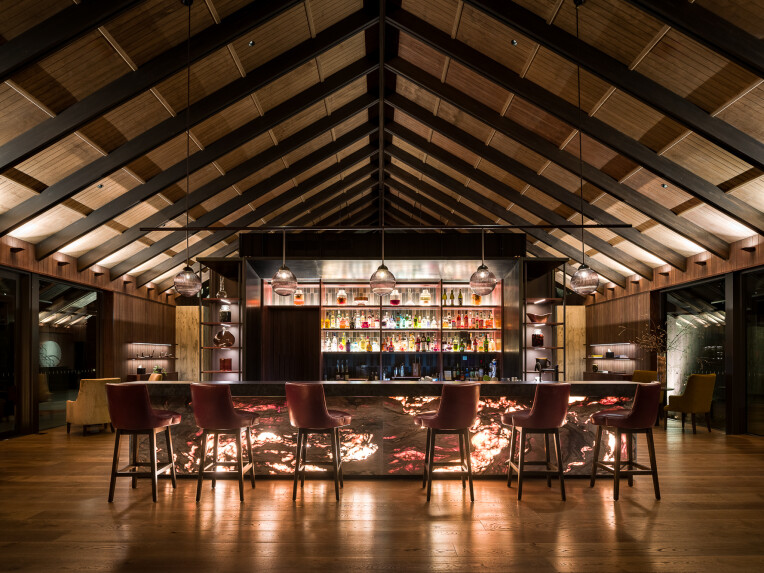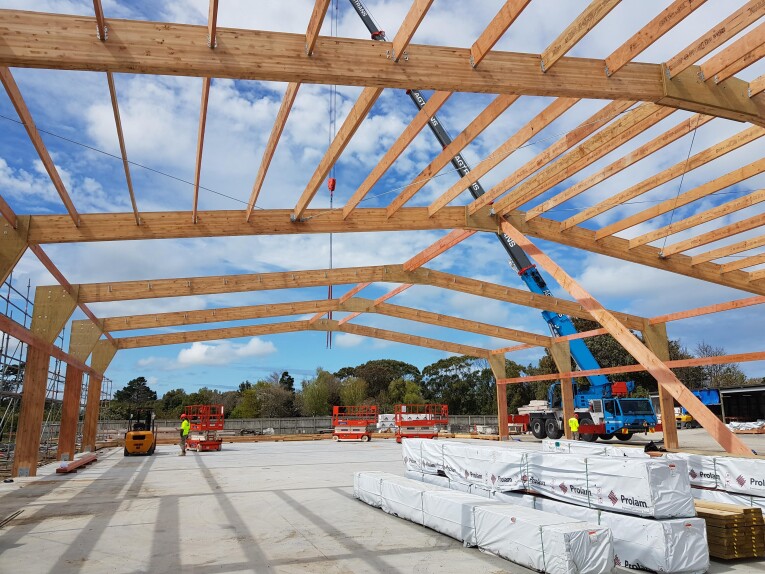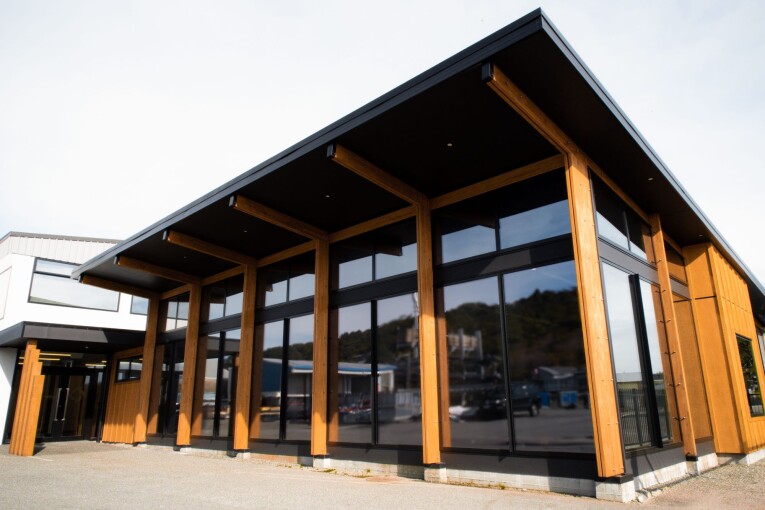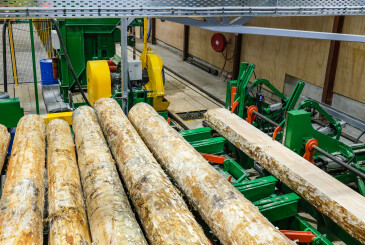A guide to using structural timber in commercial builds

Across New Zealand, high-performance engineered timber is transforming commercial construction – delivering the strength and sustainability that today’s projects demand.
From schools to office buildings, tourism and hospitality venues to industrial complexes, structural timber is emerging as a smart, sustainable and cost-effective alternative to steel and concrete.
In this guide, we explore why engineered timber like glulam is on the rise in commercial construction and the benefits it offers across different applications. We also share insights from Prolam’s structural engineers, including practical design and construction tips for using glulam in large, commercial-scale projects.
A growing mass timber movement
A global movement towards mass timber construction is gaining serious traction in New Zealand – supported by research, policy, and advocacy from organisations like BRANZ and Timber Unlimited.
Driven by the New Zealand Government’s Building for Climate Change programme and industry-wide carbon reduction goals, developers and design and construction professionals are increasingly looking to timber as a renewable, low-carbon alternative to steel and concrete.
But the appeal isn’t just environmental. Engineered timber systems deliver exceptional performance, fast installation, and striking aesthetics – making them ideal for commercial projects that demand both scale and character.

Whitby Collegiate by Andrew Sexton Architecture. Product: Prolam Visual PL8 Beams.
What is engineered timber – and where does glulam fit in?
Engineered timber refers to wood products manufactured by bonding layers of timber together to create consistent, high-performance structural members. The process enhances strength, stability, and design flexibility – while minimising timber waste, and the variability found in solid timber products.
Glued laminated timber, cross-laminated timber and laminated veneer lumber are the three types of engineered timber available in the New Zealand market:
Glued laminated timber (or glulam) is made by bonding multiple layers of finger-jointed timber pieces, called lamella, with adhesives. This process provides superior strength and stiffness, enabling glulam to be manufactured in large sizes and long spans to suit complex structural and architectural requirements. Suitable for both interior and exterior applications, Glulam can be used for structural timber beams, posts, and portals, purlins and girts, as well as aesthetic features such as exposed trusses and façades in residential and commercial construction.
Cross-laminated timber (CLT) is made by stacking and bonding timber boards in perpendicular layers, creating large solid panels. The cross-laminated structure provides strength in two directions, making CLT ideal for walls, floors, roofs, and shear walls. It is commonly used for floor and wall panels, roof slabs, and lateral bracing in mass timber structures.
Laminated veneer lumber (LVL) is made from thin wood veneers bonded together with adhesives to form a stable product. It delivers high strength and stiffness but is typically suited to interior use – its veneers are only surface treated (H1.2), making it unsuitable for exterior or in-ground applications.
When paired together, glulam and CLT form an integrated mass timber system, enabling efficient, low-carbon structures with outstanding structural properties.

The benefits of glulam structural timber for commercial projects
When most people think of timber, they picture warm, natural finishes and architectural appeal. However, structural timber’s advantages go well beyond its aesthetics and glulam’s structural properties make it a compelling choice for commercial applications.
1. Strength and stability
Engineered for performance, glulam offers an excellent strength-to-weight ratio. It has a spanning and load-bearing capacity that can match steel or concrete, and is more dimensionally stable than solid timber.
2. Faster, easier, cost-effective construction
Prefabricated glulam timber members are lightweight and easy to transport and install – reducing labour and onsite time. Smaller foundation requirements compared to heavy steel or concrete further increase its efficiency as a building material.
3. Sustainability built-in
As a renewable, carbon-storing material, engineered timber helps lower embodied carbon and store carbon over a building’s life. Prolam glulam solutions are backed by independently verified Environmental Product Declarations (EPDs), supporting Green Star and HomeStar credits.
4. Fire and seismic performance
Unlike steel, glulam retains its strength under high heat due to predictable charring rates. Its lightweight flexibility also delivers strong seismic performance – ideal for New Zealand’s conditions.
5. Scale and versatility
Custom-manufactured to order, glulam can achieve impressive spans and load-bearing capacities for large, open spaces – from school halls and airports to retail, hospitality and industrial facilities, as well as large-scale commercial builds such as retirement villages.
6. Architectural appeal
Natural and timeless – timber brings a biophilic quality to commercial interiors and exteriors, enhancing visual impact and comfort for occupants.

Sugarloaf at Flockhill by Hierarchy Group. Product: Prolam PL8 Beams.
Structural timber design considerations
Maximising the use of mass timber in commercial buildings starts with early collaboration between architects, engineers, and timber manufacturers.
Prolam's in-house structural timber engineers work closely with project teams to ensure a design achieves the desired strength, durability, compliance, and aesthetic goals using glulam. Key considerations they highlight for successful timber design include:
- Specialist structural timber design know-how:
Bring in a timber design specialist from the concept stage to optimise structure, compliance, and constructability. - Plan for exposure and moisture:
Select the right treatment and finishes and establish a long-term water management strategy which includes moisture monitoring. - Think hybrid:
Use a strategic mix of materials (glulam and CLT, steel, concrete) where it makes sense to maximise strength and performance. - Design for prefabrication:
Accurate detailing ensures fast, efficient installation on site. - Consider compliance pathways:
Understand building code requirements, fire rating, seismic performance, and other regulatory considerations early in the design process.

The Metlifecare Retirement Village under construction. Product: Prolam PLX Portal.
How Prolam supports commercial projects
At Prolam, we’re more than a glulam manufacturer and supplier – we’re a structural timber design partner.
Our in-house engineers collaborate with architects and construction companies across New Zealand to design and deliver practical glulam solutions for mass timber construction.
We offer:
- Design support:
Expert engineering input from concept through to installation that complements and builds upon a project team’s knowledge and design experience. - Comprehensive product range:
Standard and custom visual and non-visual grade glulam beams, posts, portals and trusses for commercial-scale projects. - Specification tools:
Free access to the Prolam Specifier and the Prolam Specific Engineering Design Guide for data for calculations and compliance. Prolam is also on SpecToolbox. - Building consent:
Tested and code-compliant products, backed by PS1 statements, CodeMark certification for posts, and full documentation to ensure smooth building code consent.
We are also working with engineers, architects and building professionals, as well as government and research institutions, to take structural timber design to the next level in our innovation engine room, ProLab – researching and developing practical solutions for mass timber construction.

The Presco Factory under construction. Product: Prolam Visual PL12 Beams.
Structural timber solutions for New Zealand projects
Prime Fluid Management Office
Prime Fluid Management, a leader in fluid management solutions for the civil, mining, municipal, agricultural, and industrial sectors, required additional office space that maintained a modern aesthetic and low-carbon footprint.
Prolam Visual Glulam Beams and Posts were selected for their strength, durability, and aesthetic appeal. The PL8 H3.2 Beams and PL8 H5 Posts form exposed timber features both inside and outside the building. The beams extend from the overhanging roofline through the interior, creating a seamless architectural feature that defines the building’s look.

The façade of the Prime Fluid Management office. Products: Prolam visual PL8 Beams and PL8 H5 Posts.
Karori Normal School
As part of a major redevelopment, Karori Normal School introduced a new two-storey teaching block housing eight modern classrooms.
Prolam Visual PL12 H3.2 Beams were used to construct frames at the edge of a covered deck, forming the building’s striking façade. Engineered to support translucent panels, these timber frames provide shelter from Wellington’s famously windy weather while maintaining openness and light. The choice of Prolam glulam beams was critical to achieving both form and function: structurally strong, dimensionally stable, and visually refined for a highly visible architectural element.
Karori Normal School by Stephenson & Turner. Products: Prolam Visual PL12 Beams.
Ready to build better (and bigger) with Prolam?
Talk to Prolam’s structural timber design experts about how our engineered timber products and structural timber design services can support your next commercial project.
FAQs about glulam in commercial builds
Is glulam timber suitable for large-scale commercial buildings?
Yes. Glulam’s strength, spanning and load-bearing capability make it ideal for commercial building applications. Available in a wide range of standard sizes and visual grade and non-visual grade finishes, and custom sizes, Prolam glulam beams, posts, trusses and innovative timber bracing systems can be used in large-scale buildings.
Where do I find glulam structural properties and technical information to support structural timber design calculations for commercial projects?
The Prolam Specifier and the Prolam Specific Engineering Design Guide provide detailed information to support structural timber design calculations for residential and commercial projects. Prolam products are available on SpecToolbox, a dedicated mass timber specification tool.
For tailored support, our in-house engineers can assist with project-specific design advice and Specific Engineering Designs, ensuring your structural timber solution aligns with commercial building requirements.
What’s the difference between glulam and CLT?
Glued laminated timber (or glulam) is made by bonding multiple layers of finger-jointed timber pieces, called lamella, with adhesives. Cross-laminated timber (CLT) is made by stacking and bonding timber boards in perpendicular layers, creating large solid panels.
Glulam is typically used for load-bearing members like beams, columns and trusses, including exposed architectural features, while CLT is used for wall and floor panels. Together, they provide solutions for mass timber construction.



